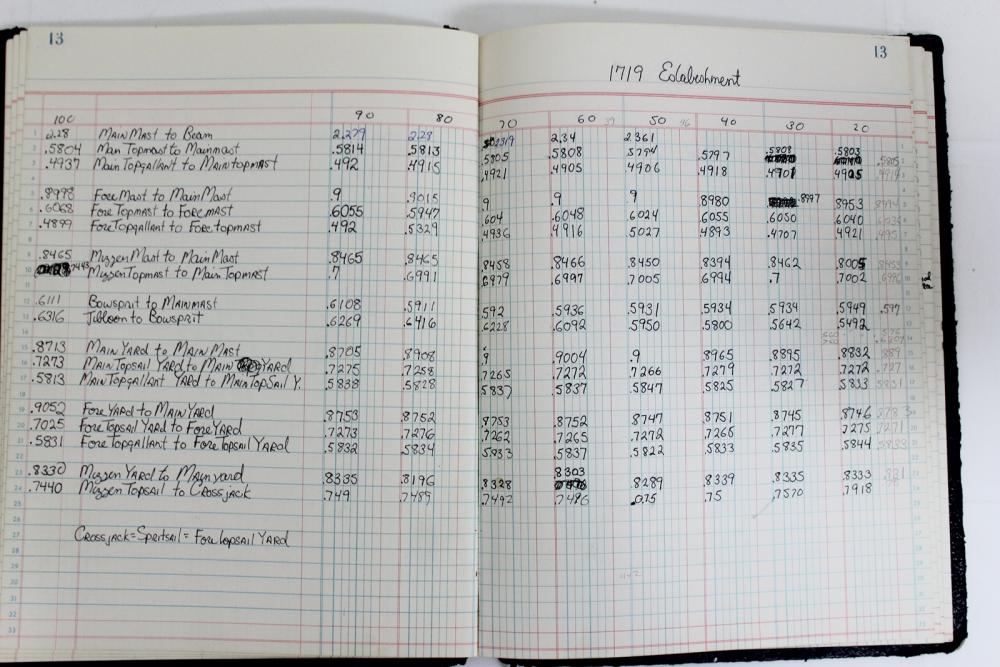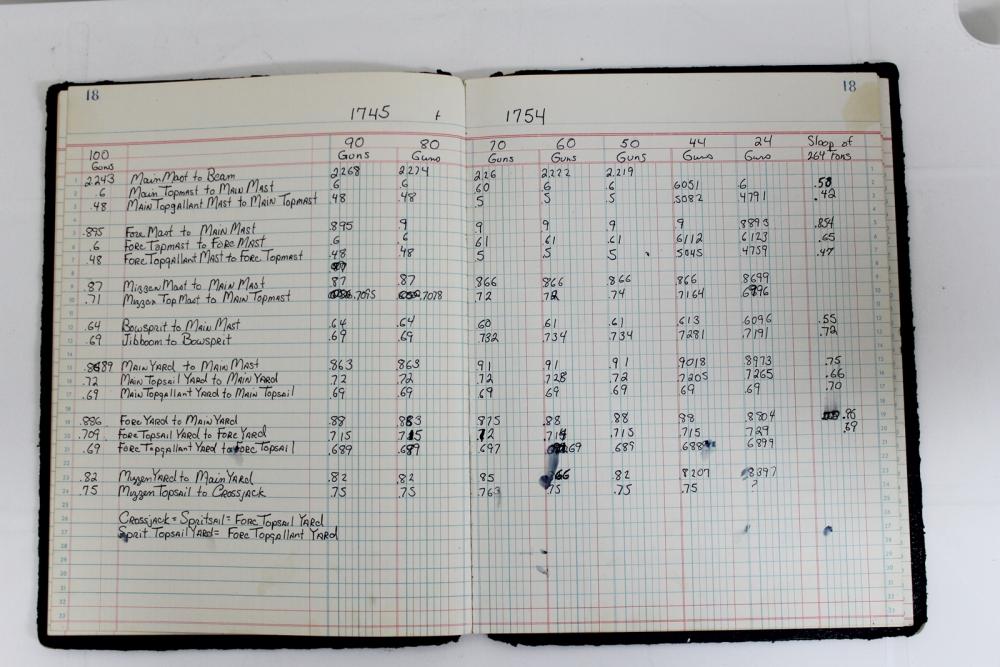-
Posts
841 -
Joined
-
Last visited
Content Type
Profiles
Forums
Gallery
Events
Everything posted by michaelpsutton2
-

Sail Plan for British brig sloop
michaelpsutton2 replied to majer1898's topic in Masting, rigging and sails
The dimesions of the seagull class are smaller than the Cruizers. I would use steels book and calculate- 3 replies
-
- Brig sloop
- rigging plan
-
(and 2 more)
Tagged with:
-

Just picked up the AL 1:48 HMS Surprise
michaelpsutton2 replied to DonInAZ's topic in Wood ship model kits
Don't forget to peruse Hunt's book on the Surprise. In addition to ton of information, it is full of eye candy. Might provide a bit of inspiration as you put in tree nail # 6,528. -

Cruizer-class Brig-Sloops of the Royal Navy
michaelpsutton2 replied to molasses's topic in Nautical/Naval History
The HMS Julia launched in 1806. Everything you need can be found in The Elements & Practice of Rigging & Seamanship" by David Steel 1794. It is online for free at http://www.hnsa.org/resources/manuals-documents/age-of-sail/the-elements-and-practice-of-rigging-and-seamanship/ If you work your way methodically through, you can reconstruct the rig fairly well -
On Nile felucca's the fore end of the yard is pulled around the mast. which means that the part of the yard before the mast has to be less than the height if the yard above the deck at the parrell.It looks like that is what is happening in the picture of the San Diego galleon. It must be a hazardous operation in a breeze if the deckhands don't know their business!
-

HMS bounty colour?
michaelpsutton2 replied to Rich12ace's topic in Painting, finishing and weathering products and techniques
After the mutiny, Capt Bligh's voyage and the trial of the mutineers the Bounty had become one of the most famous vessels in history. It was big news several times years apart. Had she been painted in any but the most normal colors of the day surely it would have been mentioned. You could picture some old harbor drunk saying"I knew that bright pink ship would come to no good" But all the sources are silent on her appearance, so it must have been plain as can be. I wouldn't get to decorative. If you look at William Dodd's aquatint of Captain Bligh being put into the boat, there is not a drop of blue on her. Dodd was contemporary with the events but I do not think he could ever have claimed to have seen her. He could have met some those who sailed on her though color scheme used on the recent Endevour replica would probably serve. Here is one I think might not be too far off: http://www.stephensandkenau.com/ship/hms-bounty/ https://en.wikipedia.org/wiki/William_Bligh#/media/File:Mutiny_HMS_Bounty.jpg -

HMS bounty colour?
michaelpsutton2 replied to Rich12ace's topic in Painting, finishing and weathering products and techniques
http://archive.archaeology.org/9905/etc/bounty.html Maybe this will be of some interest -

HMS bounty colour?
michaelpsutton2 replied to Rich12ace's topic in Painting, finishing and weathering products and techniques
The Bounty was copper sheathed. The copper is still being found at her gravesite at Pitcairn Island -

HMS bounty colour?
michaelpsutton2 replied to Rich12ace's topic in Painting, finishing and weathering products and techniques
There are no known contemporary pictures of her. The cover of the "Anatomy of the Ship" series book is about as close as anything. But look carefully a lot of what appears black is really dark brown. I grew up with the image of the bounty from the 1960's movie: Blue Hall with yellow molding. It hard to let go of and accept the duller but more likely alternative -
I am just now looking at your mast. I see where McLean points out that some masts were "filled under the hoops". The fact that he takes note of it for some ships means that it was not universal. Which way are you going?
- 3,618 replies
-
- young america
- clipper
-
(and 1 more)
Tagged with:
-

MONTAÑES by Amalio
michaelpsutton2 replied to Amalio's topic in - Build logs for subjects built 1751 - 1800
The compound curves up to the counter a superbly articulated -

Sources for Rigging tables before Steel 1794 wanted
michaelpsutton2 replied to archnav's topic in Masting, rigging and sails
Absolutely yes the Medway. But the question I am asking is a larger and more general one. Imagine the meeting or meetings where the new Establishment was agreed on sometime in 1745. Don't you think that sailors captains rigger, so called technical experts would have been called in. Ship's top hamper was constantly being repaired, modified, and experimented with. Look at the never ending discussions on this website about the finer points of Old Ironsides rig. So I think these guy showed up and said "here are some things we have been doing at sea over the last few years that improve performance".And they got them made official. Under that scenario you might reasonably find some of the changes of 1745 actually in use on ship prior to that time. Everyone is fixated on the ratio of beam to mainmast. True enough and it changes over time. But the other spars changed in relation to the main mast as well. In particular the length of the topgallant yards in relation to the length of the other yard increased steadily over the years. You can see from my tables abovevtheratio of topgallant yard yo topsail yard went from .58 in 1719 to .69 in 1745.The ratio of the topsail yard to the main yard remained at .7 The ratio of the topgallant mast to the top mast remained the same as well at about .48-.49. The topgallants in 1745 were noticblely wider in proportion to thier depths and to the topsails in 1745 than in 1719. This had the effect of reducing the taper of the sail plan as it went up. I ma certainly not an engineer but it must have been improvements in hull stability and spar materials that allowed them to raise the center of effort. So the question is which Establishment do my self titled" inter-Establishment" ship look most like. -

Sources for Rigging tables before Steel 1794 wanted
michaelpsutton2 replied to archnav's topic in Masting, rigging and sails
I think maybe my question has been misunderstood. Years ago I calculated the ratios for different periods from the tables in Lees (see attached). What I am trying to figure out is when to use the 1745 ratio, possibly adjusted for beam and when to use the 1719 ratios, again adjusted for beam. Would you use the 1719 ratios, adjusted for beam, on ships of the 1733 & 1741 proposals, or the 1745. The 1745 ratios produce a sail plan that is quite a bit wider at the top. Squarer if you will. By the way if anyone wants copies of the ratios, just drop me line. -

Sources for Rigging tables before Steel 1794 wanted
michaelpsutton2 replied to archnav's topic in Masting, rigging and sails
So taking as an example HMS Medway 1742. She had a beam of 41'5", some 6% more than the 1719 Establishment spec of 39'. And a displacement of 1080 tons a full 13% more than the 1719 number. You would take the 1719 spar dimensions and proportionally increase them by something. But you would not use the proportions of 1745. By the way a bit of rather imprecise Photoshop work to allow for perspective and lens distortion with the pic's I have seems to show that the ratios of the yards to one another on the NMM model is closer to what we see in the 1719 Establishment than to 1745. It is of course almost impossible to get good measurements with pictures taken at random and unknown angles. -

Sources for Rigging tables before Steel 1794 wanted
michaelpsutton2 replied to archnav's topic in Masting, rigging and sails
I do understand that the changes in the dimensions of the ships were on the whole relatively conservative. So do the 1719 spar dimensions hold true up until Jan 1, 1745? Or had they been "field" tested prior to that date? -

Sources for Rigging tables before Steel 1794 wanted
michaelpsutton2 replied to archnav's topic in Masting, rigging and sails
Did the promulgation of the 1745 Establishment initiate a change in the spar proportions or did it formalize practices already in use in the fleet? As an example would you imagine a vessel of the late 1730's or early 1740's with the spars of 1719 or something approaching those of 1745. The 1745 sail plans are wider at the top. That is the top-gallant yards increased more than the lower ones. The vessels of the 1733 & 1741 proposals are wider and have a larger displacement, so they would be able to stand up under a larger press of sail. Just for the record this is the first time I have ever used the word promulgagted and I am so proud, -

Sources for Rigging tables before Steel 1794 wanted
michaelpsutton2 replied to archnav's topic in Masting, rigging and sails
Darn...I suspect it may be a bit before I can pop on over to the UK. I wonder why someone, anyone (Allan) doesn't publish the full data from all of the establishments. -

Sources for Rigging tables before Steel 1794 wanted
michaelpsutton2 replied to archnav's topic in Masting, rigging and sails
Does anyone know where to find a complete copy of the1719 or 1745 Establishment? Have they ever been published? -

Sources for Rigging tables before Steel 1794 wanted
michaelpsutton2 replied to archnav's topic in Masting, rigging and sails
You hardly ever here the word snippet used in conversation these days -

Sources for Rigging tables before Steel 1794 wanted
michaelpsutton2 replied to archnav's topic in Masting, rigging and sails
In Brian Lavery's "Ship of the Line" page 171, there is a table for the "Proportions of rigging for his majesty's dhips of the First, Second, & Third Rates" -

Sources for Rigging tables before Steel 1794 wanted
michaelpsutton2 replied to archnav's topic in Masting, rigging and sails
Or for even earlier "Deane's "Doctrine of Naval Architecture". Are you looking mostly for the sizes of the rigging or the run of it. -

Sources for Rigging tables before Steel 1794 wanted
michaelpsutton2 replied to archnav's topic in Masting, rigging and sails
Get yourself a copy of "Sutherland's shipbuilders assistant" 1711 -
You should have weighed it before mounting to the stand. 4,5,6 ounces maybe. What a thing to be made of some twigs and a few chips! Hardly anything of this world. Truly it is made only of imagination, determination and the kind of skill That takes long years to acquire.
- 641 replies
-
- greenwich hospital
- barge
-
(and 1 more)
Tagged with:
About us
Modelshipworld - Advancing Ship Modeling through Research
SSL Secured
Your security is important for us so this Website is SSL-Secured
NRG Mailing Address
Nautical Research Guild
237 South Lincoln Street
Westmont IL, 60559-1917
Model Ship World ® and the MSW logo are Registered Trademarks, and belong to the Nautical Research Guild (United States Patent and Trademark Office: No. 6,929,264 & No. 6,929,274, registered Dec. 20, 2022)
Helpful Links
About the NRG
If you enjoy building ship models that are historically accurate as well as beautiful, then The Nautical Research Guild (NRG) is just right for you.
The Guild is a non-profit educational organization whose mission is to “Advance Ship Modeling Through Research”. We provide support to our members in their efforts to raise the quality of their model ships.
The Nautical Research Guild has published our world-renowned quarterly magazine, The Nautical Research Journal, since 1955. The pages of the Journal are full of articles by accomplished ship modelers who show you how they create those exquisite details on their models, and by maritime historians who show you the correct details to build. The Journal is available in both print and digital editions. Go to the NRG web site (www.thenrg.org) to download a complimentary digital copy of the Journal. The NRG also publishes plan sets, books and compilations of back issues of the Journal and the former Ships in Scale and Model Ship Builder magazines.




